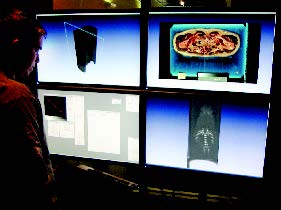Two of the GPGPU/Visualization cluster nodes are located in OSC’s Interface Lab. One system is connected to a four-panel video wall (above) and the other to a passive stereo projection system.
The gaming industry, with its consumer demand for realistic, smooth, 3-D images, is without a doubt advancing the graphics hardware market exponentially. In recent years, commodity-based graphics chips or graphical processing units (GPUs) have become more programmable and easier to use for general purpose applications (GPGPU).
Researchers are starting to use these single process, multiple data parallel processors to accelerate image processing algorithms and line of sight calculations, in addition to real-time deformation calculations.
Understanding that demand for this technology will only continue to grow, the Ohio Supercomputer Center installed a GPGPU/Visualization cluster in 2007. The system’s configuration contains:
• 36 AMD Opteron 2.6GHz dual-core CPUs
• 36 NVIDA Quadro FX 5600 GPUs
• Infiniband Dual Port HCA card
• 144 gigabytes of RAM
• 13,500 gigabytes SATA hard disk
Each Quadro FX 5600 card has 1.5 gigabytes of onboard, high-speed memory and is capable of 330 peak gigaflops. Combined, the 36 GPUs of the cluster are capable of 11,800 peak gigaflops, and, most importantly, are fully programmable. This level of memory, speed, and programmability is a necessity for realistic graphics and a boon for researchers wanting to use GPGPU for their data sets.
“Our goal is to create an environment for Ohio’s researchers to tap the latest graphics technology, whether it’s for GPGPU computation or visualization,” said Dennis Sessanna, director of hardware - Interface Lab, Ohio Supercomputer Center. “In addition to the hardware, the cluster is running GPU-accelerated application program interfaces such as CUDA, Cg, and GLSL. These interfaces make it easier for non-programmers to use the GPUs for their studies.
“Initial performance studies show that some common scientific algorithms completed 50 to 100 times faster on the GPGPU/Visualization cluster than they would have on a comparable CPU-based supercomputer,” Sessanna said. “However, not all algorithms will perform this well on a GPU. We’re helping our clients determine what applications can be optimized for the graphics processor.”
The cluster also enables researchers to access the cluster’s graphics cards and perform data-intensive visualizations in real-time, from viewing 3-D medical data to creating simulation models. The resulting images are then interactively streamed back to their desktop.
--
Project Lead:
Dennis Sessanna, Ohio Supercomputer Center
OSC Project Team:
• Don Stredney
• Ashok Krishnamurthy, Ph.D.
Research Title:
HHS-OBOR: Cluster Computing Capacity
Funding Source:
Ohio Board of Regents
For more information:
